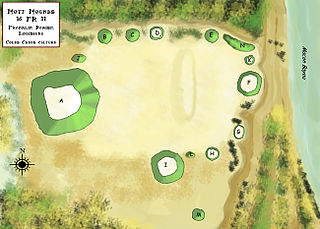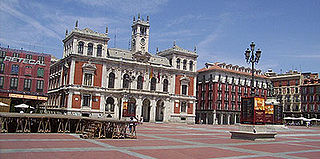The Taensa were a Native American people whose settlements at the time of European contact in the late 17th century were located in present-day Tensas Parish, Louisiana. The meaning of the name, which has the further spelling variants of Taenso, Tinsas, Tenza or Tinza, Tahensa or Takensa, and Tenisaw, is unknown. It is believed to be an autonym. The Taensa should not be confused with the Avoyel, known by the French as the petits Taensas, who were mentioned in writings by explorer Pierre Le Moyne d'Iberville in 1699. The Taensa are more closely related to the Natchez people and both are considered descendants of the late prehistoric Plaquemine culture.

The Anna Site is a prehistoric Plaquemine culture archaeological site located in Adams County, Mississippi 10 miles (16 km) north of Natchez. It is the type site for the Anna Phase of the Natchez Bluffs Plaquemine culture chronology. It was declared a National Historic Landmark on September 14, 1993.

Kings Crossing Site is an archaeological site that is a type site for the Kings Crossing Phase of the Lower Yazoo Basin Coles Creek chronology.

The Plaquemine culture was an archaeological culture centered on the Lower Mississippi River valley. It had a deep history in the area stretching back through the earlier Coles Creek and Troyville cultures to the Marksville culture. The Natchez and related Taensa peoples were their historic period descendants. The type site for the culture is the Medora Site in Louisiana; while other examples include the Anna, Emerald, Holly Bluff, and Winterville sites in Mississippi.

Ghost Site Mounds is an archaeological site in Tensas Parish, Louisiana with an Early to Middle Coles Creek culture component and a Late Coles Creek to Plaquemine culture component.

Fitzhugh Mounds is an archaeological site in Madison Parish, Louisiana from the Plaquemine\Mississippian period dating to approximately 1200–1541 CE. It is the type site for the Fitzhugh Phase(1350-1500) of the Tensas Basin Plaquemine Mississippian chronology.

Wade Landing Mound is an archaeological site of the Coles Creek culture in Caldwell Parish, Louisiana.

Scott Place Mounds is an archaeological site in Union Parish, Louisiana from the Late Coles Creek-Early Plaquemine period, dating to approximately 1200 CE. The site is one of the few such sites in north-central Louisiana.

Venable Mound is an archaeological site in Morehouse Parish, Louisiana with a single mound with components from the Troyville, Coles Creek and Plaquemine period.

The Raffman Site is an archaeological site located in Madison Parish, Louisiana and constructed between 700 and 1200 CE. It has components from the Tchefuncte culture and the Coles Creek culture, whose main period of occupation was during the Balmoral Phase(1000-1100 CE) of the Tensas Basin and Natchez Bluffs chronology and which was virtually deserted by the end of the Preston Phase .

Sundown Mounds is an multimound archaeological site in Tensas Parish, Louisiana from the Early Coles Creek culture. It is the type site for the Sundown Phase of the Tensas Basin and Natchez Bluff Coles Creek chronology.

Flowery Mound is an archaeological site in Tensas Parish, Louisiana with components from the Late Coles Creek and Plaquemine-Mississippian culture which dates from approximately 950–1541.

Marsden Mounds is an archaeological site with components from the Poverty Point culture and the Troyville-Coles Creek period. It is located in Richland Parish, Louisiana, near Delhi. It was added to the NRHP on August 4, 2004, as NRIS number 04000803. It is the type site for the Marsden Phase of the Tensas Basin and Natchez Bluff regions local chronology.

Routh Mounds is a Plaquemine culture archaeological site in Tensas Parish, Louisiana. It is the type site for the Routh Phase(1200 to 1350 CE) of the Tensas Basin Plaquemine Mississippian chronology. It is located approximately 2 miles (3.2 km) northwest of the Winter Quarters State Historic Site.

The Mott Archaeological Preserve or Mott Mounds Site is an archaeological site in Franklin Parish, Louisiana on the west bank of Bayou Macon. It originally had eleven mounds with components from the Marksville, Troyville, Coles Creek, and Plaquemine periods. It was at one time one of the largest mound centers in the Southeast and has one of the largest mounds in Louisiana with a base which cover more than two acres. It was purchased by the Archaeological Conservancy in 2002. and is now used for research and educational purposes.

Julice Mound is an archaeological site in East Carroll Parish, Louisiana with a Plaquemine culture component dating to 1200–1541 CE and located less than one mile from Transylvania Mounds.

Bayou Grande Cheniere Mounds is an archaeological site in Plaquemines Parish near the southeast corner of Louisiana. Built by the Coastal Coles Creek culture, it was inhabited from 875 to 1200 CE, from the Early Coles Creek period to the Coles Creek/Plaquemine period.

The Sims Site (16SC2), also known as Sims Place, is an archaeological site located in Saint Charles Parish, Louisiana, near the town of Paradis. The location is a multi-component mound and village complex with platform mounds and extensive midden deposits. The site habitations are divided into three periods. It was first inhabited about 800 CE by peoples of the Coastal Coles Creek culture. By 1100 CE the culture of the site had transitioned into the Mississippianized Plaquemine culture that lasted until 1450 CE. A little later was a Late Mississippian/protohistoric period that lasted from 1500 until about 1700 or 1800.

The Glass Site is a Plaquemine culture archaeological site located approximately 9.5 kilometres (5.9 mi) south of Vicksburg in Warren County, Mississippi. Originally the site had four platform mounds surrounding a large open plaza, but land leveling for modern farming techniques and looting by pothunters mean only portions of three have survived into the 21st century. It was a major ceremonial center that was contemporaneous with other large Plaquemine sites including Emerald, Holly Bluff, and Winterville and whose main occupation period occurred during the protohistoric period from 1500 to 1650 CE. Parts of the site were excavated by Clarence Bloomfield Moore in 1910 and 1911, and by Lauren Elizabeth Downs in 2007-2009.














